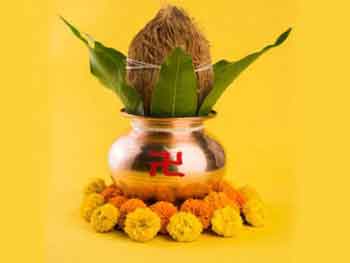INVC NEWS
Chennai ,
Introduction
Earthen pots, also known as Kalash or pitchers, have held a significant place in various cultures and traditions around the world. These humble vessels have been particularly cherished for their ability to keep water cool, making them indispensable during the scorching summer months. While their prevalence may have diminished in the modern era, rural areas still embrace the tradition of using Kalash to drink water in every household. Moreover, these beautifully decorated urns continue to play a vital role in religious ceremonies such as worship, housewarming, and marriages. In this article, we delve into the origins of the Kalash and its deep-rooted symbolism.
Historical Significance
Determining the exact origin of the Kalash is challenging due to its ancient lineage. Historical evidence suggests that pottery-making dates back to the Harappan culture, further indicating the practice of using clay water vessels in prehistoric times. Small idols discovered in the Czech Republic, dating between 2900 to 2500 BC, affirm the prevalence of clay water vessels in our country since ancient times. The installation of an urn during worship, accompanied by praises, is a long-standing tradition. These praises highlight the Kalash’s connection to the churning of the ocean by gods and demons, emphasizing its significance as a vessel embodying various deities and divine powers.
The Mythological Connection
According to legends, during the churning of the ocean, Vishwakarma, the divine architect, crafted an urn to hold the nectar produced from this celestial event. Vishnu, the preserver of the universe, then adorned this sacred vessel. Another account depicts Dhanvantari, considered an incarnation of Vishnu, appearing with the vessel filled with nectar. Later, when demons seized the pot, Vishnu transformed into Mohini, a bewitching enchantress, and facilitated the deities in reclaiming the nectar. These narratives reinforce the association of the Kalash with Vishnu and the divine cosmic events that unfolded during the churning of the ocean.
Invocation and Symbolism
In the elaborate rituals involving the Kalash, the worshipper invokes Varuna, the god of the sea and water, along with other deities. Specific sections of the Kalash symbolically represent different entities. For instance, Vishnu is associated with the mouth of the urn, Rudra with the throat, Brahma with the root, and various maternal deities with the middle section. The Kukshi (belly) represents the Earth and its oceans, while the circumference of the mouth forms a circle denoting the Rigveda and other Vedangas. Additionally, the Kalash embodies the goddesses Gayatri, Savitri, Shanti, Pushti, and revered rivers like the Ganga.
Types of Kalash
The ‘Kalika’ Purana classifies the Kalash into nine distinct types, each with its unique characteristics and names. These include Gohya, Upagohya, Marut, Mayukh, Manohar, Ataryabhadra, Vijay-Tanushodhak, Indriyaghna, and Vijay. These urns are also referred to as Kshitindra, Jalsambhava, Pawan, Agni, Yajman, Koshasambhava, Som, Aditya, and Vijay, respectively. Each classification holds its symbolic significance and is associated with specific rituals and ceremonies.
Evolution and Significance
The Kalash initially emerged as a vessel to store nectar. Over time, its purpose expanded beyond water storage and daily use to encompass its role in Yagya Sadhan, or ritualistic practices. The Kalash transitioned from clay to metal, including iron, brass, bronze, copper, silver, and gold, showcasing its evolution and the increasing display of prosperity. Despite its material form, the Kalash has retained its sanctity and continues to occupy a significant place in religious rituals.
Kalash in Religious and Cultural Traditions
The Kalash finds widespread usage in various religious festivals, albeit in varying quantities. Large-scale yagyas often incorporate numerous urns, ranging from eight to 108 in number. An enchanting sight unfolds during marriage ceremonies when brides, adorned in red and yellow attire, carry water-filled pots atop their heads in a procession towards the Yagya Mandap, chanting verses and hymns. These visually captivating traditions exemplify the integral role of the Kalash in our religious and cultural heritage.
Symbolic Water and Tradition
In the etymology of the word “Kalash,” it is stated, ‘ken jalen lasati shobhate iti kalashah,’ which means that being filled with water enhances its beauty. Water is considered an essential element for the Kalash, and the inclusion of dry leaves or an empty vessel diminishes its significance. It is important to preserve the original intent and symbolism associated with the Kalash by ensuring that it is kept filled with water and adorned appropriately.
Conclusion
The Kalash stands as a powerful symbol of Varuna, the god of the ocean and water, carrying deep-rooted mythological and cultural significance. Its origins trace back to ancient times, with references found in historical accounts and mythological narratives. The diverse classifications of the Kalash reflect its evolving nature, transitioning from a vessel for nectar to an integral component of religious and cultural traditions. As we cherish and uphold these customs, it is crucial to understand and honor the spiritual essence represented by the Kalash, preserving its rich heritage for generations to come.












